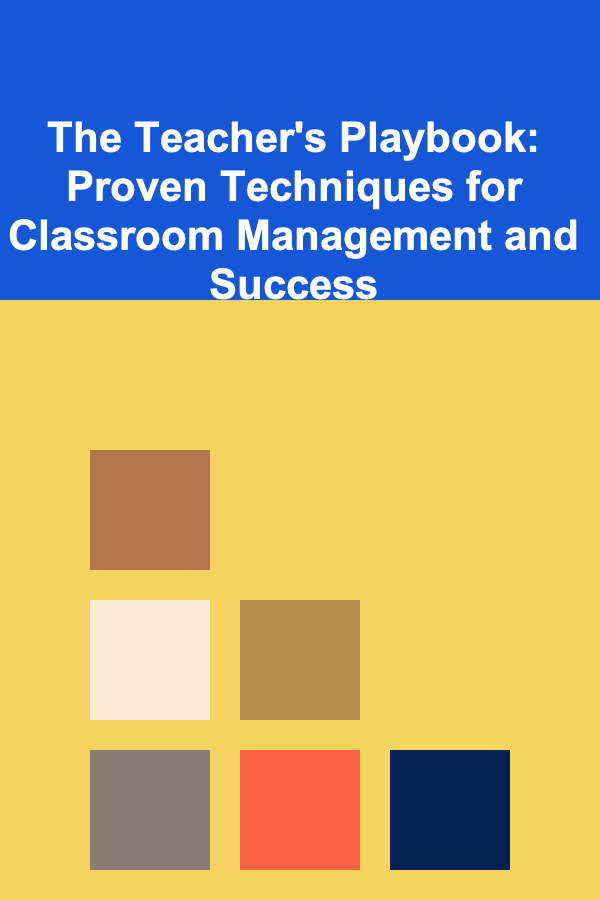
The Teacher's Playbook: Proven Techniques for Classroom Management and Success
ebook include PDF & Audio bundle (Micro Guide)
$12.99$10.99
Limited Time Offer! Order within the next:

Classroom management is one of the most critical skills that educators need to develop. It's not just about maintaining order, but creating an environment where students feel respected, engaged, and motivated to learn. Effective classroom management contributes to a positive learning atmosphere that nurtures both academic success and personal growth for students. The challenge for teachers, particularly those in the early stages of their careers, is learning how to manage diverse groups of students with varying needs, behaviors, and learning styles.
In this guide, we will explore proven techniques for classroom management and success, focusing on both practical strategies and theoretical frameworks that educators can apply. By incorporating these techniques into daily teaching practices, teachers can set themselves up for sustained success in fostering a productive and positive classroom environment.
Establish Clear Expectations and Routines
Define Classroom Rules Early
The foundation of effective classroom management begins with establishing clear rules and expectations from day one. By setting the tone early, students understand what is expected of them, and what the consequences are for not meeting those expectations.
- Be specific: Rather than general rules like "Be respectful," offer clear examples of what respect looks like (e.g., listening when someone is speaking, raising your hand to ask questions).
- Involve students: Allowing students to be part of the rule-making process can increase their buy-in and commitment to following them. For instance, having a class discussion on what behaviors help everyone learn can lead to meaningful rules.
- Post rules visibly: Place a poster of the classroom rules in a visible location where students can refer to them throughout the day.
Consistency is Key
Consistency in enforcing the rules is one of the most important aspects of classroom management. When students see that the teacher consistently applies the same consequences for the same behaviors, they learn to associate their actions with outcomes, whether positive or negative.
- Follow through: Always follow through with the consequences for misbehavior or rewards for good behavior. If you say there will be a consequence for not following a rule, ensure it happens every time.
- Clear and predictable: Students thrive on routine. Predictability helps reduce anxiety and allows students to focus on learning rather than worrying about what will happen next.
Implement Routines for Daily Activities
Establishing routines for common classroom activities (e.g., entering the classroom, handing in homework, transitions between subjects) ensures that students know what is expected of them at any given time. This helps to minimize disruptions and maximize learning time.
- Start each day with a routine: Develop a morning routine that gives students a sense of structure and focus. For example, having a "Do Now" activity on the board for students to complete as soon as they enter can set a productive tone.
- Use transitions efficiently: Transitions between subjects or activities can lead to chaos if not managed well. Give clear, time-specific instructions (e.g., "In two minutes, we'll move from math to reading. Please put away your math books and take out your reading materials").
Foster a Positive and Inclusive Learning Environment
Build Relationships with Students
Effective classroom management isn't solely about discipline---it's about creating an environment where students feel safe, valued, and respected. Building strong relationships with students is key to preventing behavioral issues and promoting engagement.
- Get to know students individually: Taking the time to learn about students' interests, backgrounds, and challenges can help teachers better support their academic and social-emotional development.
- Show empathy and understanding: Sometimes, students act out due to personal challenges or unmet needs. A teacher who shows empathy and addresses the root causes of behaviors can prevent issues before they escalate.
Encourage Student Engagement
When students are actively engaged, they are less likely to engage in disruptive behaviors. Engaged students are focused on the content, invested in their learning, and excited to participate in classroom activities.
- Incorporate active learning: Use interactive teaching methods such as group discussions, hands-on activities, or problem-solving tasks that encourage students to actively participate.
- Vary teaching methods: Mix different teaching strategies to cater to diverse learning styles. For instance, pair lectures with multimedia, group work with individual assignments, and discussions with physical activities to keep students engaged.
Promote Respect and Responsibility
A classroom where respect and responsibility are emphasized is one where students hold themselves and their peers accountable for their behavior. This creates a collaborative and supportive atmosphere.
- Model respect: Teachers are role models. Demonstrating respectful behavior and communication sets the standard for how students should interact with one another.
- Foster responsibility: Give students opportunities to take ownership of their learning. This might involve assigning leadership roles or giving them a voice in decisions that affect the classroom (e.g., choosing projects or setting group goals).
Utilize Proactive and Reactive Strategies
Proactive Classroom Management
Proactive management involves anticipating potential issues before they arise and putting strategies in place to prevent them. This includes planning your lessons, organizing the classroom, and setting a clear structure for the day.
- Clear, engaging lesson plans: Boring lessons can lead to distractions and behavioral problems. Keeping students engaged with well-organized, dynamic, and relevant content helps reduce disruptive behaviors.
- Classroom seating arrangement: Arrange desks in a way that minimizes distractions. For example, seating students who tend to disrupt near the front or in pairs with peers who have strong work habits can help improve focus.
Reactive Classroom Management
Despite proactive efforts, misbehavior will still occur from time to time. In such cases, it's important to respond in a way that is consistent, fair, and appropriate.
- Stay calm and composed: When confronted with misbehavior, keeping a calm demeanor and addressing the issue without anger or frustration helps maintain authority while de-escalating the situation.
- Address misbehavior privately when possible: If a student misbehaves, try to address the issue quietly and privately rather than in front of the entire class. This prevents embarrassment and gives the student a chance to reflect on their actions without being publicly reprimanded.
- Use positive reinforcement: Reinforce desirable behaviors by acknowledging and praising students when they exhibit the behaviors you want to see more of. This could be verbal praise or tangible rewards like stickers or points toward classroom privileges.
Implement Restorative Practices
Restorative practices focus on repairing harm and restoring relationships rather than punishing students. This approach fosters a sense of community and helps students understand the impact of their actions on others.
- Restorative circles: When conflicts arise, bring students together in a circle to discuss the issue and collaboratively come up with a solution. This approach encourages students to take responsibility for their actions and understand the perspectives of others.
- Conflict resolution: Equip students with the skills to resolve conflicts peacefully and respectfully. Teaching conflict resolution strategies helps students address issues on their own, reducing the number of disruptions in the classroom.
Manage Time and Space Effectively
Time management is essential to keeping the classroom running smoothly. Teachers who can manage time effectively ensure that transitions are smooth, that lessons are completed on time, and that students remain focused throughout the class period.
- Use timers and schedules: Visual or audible timers can help keep transitions brief and maintain the flow of the lesson. Having a clear, visible schedule for the day helps students know what to expect and when.
- Maximize student movement: Ensure that there are opportunities for students to move during the class. This could be through collaborative group work, rotating through activity stations, or even brief physical exercises. Movement helps re-energize students and improves focus.
Continuously Reflect and Adapt
No classroom management technique is one-size-fits-all. Every group of students is different, and what works in one classroom may not work in another. That's why reflection and adaptability are key components of successful classroom management.
- Keep a teaching journal: Reflect on what worked and what didn't after each class. If certain strategies aren't working, be flexible and willing to adjust them.
- Seek feedback from students: Occasionally ask students for feedback on the classroom environment. Are they comfortable? Do they feel the rules are fair? This feedback can help you identify areas for improvement.
- Professional development: Continuously seek out professional development opportunities, whether through workshops, mentorship, or peer collaboration. Staying current with new strategies and insights helps teachers grow and evolve in their practice.
Conclusion
Classroom management is both an art and a science, requiring a balance of structure, empathy, and flexibility. By setting clear expectations, fostering positive relationships, engaging students, and employing both proactive and reactive strategies, teachers can create a classroom environment that supports academic achievement and personal growth. Moreover, by embracing restorative practices, managing time and space effectively, and continuously reflecting on their approach, educators can navigate the complexities of classroom dynamics and ensure success for every student. With these proven techniques, teachers are equipped to create a harmonious and effective classroom that benefits everyone involved.
Other Products

How to Create a Compact Mudroom Solution
Read More
How to Make Your Holiday Decor Last Through the Season
Read More
How to Save for a Home Down Payment While Budgeting for Other Goals
Read More
How to Turn Your Travel Blog into a Photography-Driven Business
Read More
How to Use Transparent Containers for Quick Visibility
Read More